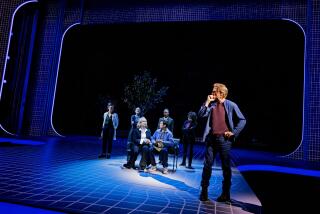A great author foresaw our discontent with the ‘Internet of Things’ -- in 1909
- Share via
Critics and Cassandras of our thralldom to secondhand experience via the Internet are hardly scarce — Jaron Lanier, Evgeny Morozov, and Clifford Stoll are only among the most cogent.
But they’d have to go far to outdo the vision of the great author E.M. Forster, who foresaw more than a century ago the soul-deadening and cataclysmic destiny of a society in worship of a machine that provides all the sensory stimulus one might crave. Forster, who is best known for novels such as “Howards End” and “A Passage to India,” outlined his dystopian predictions in a 1909 novella called “The Machine Stops.”
The remarkable precision of its observations give the story the feel of an utterly contemporary work. What’s especially notable about “The Machine Stops” is its humanism. As Sidney Perkowitz, an emeritus professor of physics at Emory University, wrote in a recent essay that reminded me of the force of a story I must first have read many decades ago, “Forster’s personal fear that the rise of machines would crush ‘such a soul as mine,’ shapes his commentary on what technology may do to people — a commentary worth reconsidering today.”
“The Machine Stops” is told from the point of view of a middle-aged lecturer named Vashti, who lives like the rest of society in a honeycomb-shaped cell underground, provided by a mysterious machine-like source with light, music, food, and social contact. She spends her life in an armchair or in bed, “a swaddled lump of flesh — a woman, about five feet high, with a face as white as a fungus.”
As the story begins, she receives a call from her son Kuno, who occupies an identical cell halfway around the world. The means of communication is a familiar one: “The round plate that she held in her hands began to glow. A faint blue light shot across it, darkening to purple, and presently she could see the image of her son.”
He has something to tell her but bizarrely (to her) wishes to do so in person. “I want to see you not through the machine,” he says. “I see something like you in this place, but I do not see you. I hear something like you through this telephone, but I do not hear you.” Vashti thinks Kuno looks sad, but she can’t be sure “for the Machine did not transmit nuances of expression. It only gave a general idea of people — an idea that was good enough for all practical purposes.”
This critique of life lived secondhand permeates the work, for personal contact is done entirely through “the machine”; even the touch of a hand is regarded as hopelessly rude. “There were buttons and switches everywhere — buttons to call for food, for music, for clothing.... There was the button that produced literature, and there were of course the buttons by which she communicated with her friends.”
Vashti’s lectures prefigure today’s craze for “distance learning” through online courses and MOOCs. “The clumsy system of public gatherings has been long since abandoned; neither Vashti nor her audience stirred from their rooms. Seated in her armchair she spoke, while they in their armchairs heard her, fairly well, and saw her, fairly well.” The ideas are all premasticated hand-me-downs. “Beware of first-hand ideas,” exclaims one sage.
Vashti does make her way to Kuno via an antiquated airship; characteristically, the view out the window of the Himalayas and other natural wonders leaves her cold. “No ideas here,” she murmurs.
Kuno’s message is that, in violation of all the rules, he has been making his way to the surface of the Earth to explore. By the end of the story he is bearing another message, that the machine that nurtures them all is running down and will soon stop. That moment arrives, bringing catastrophe, clearing the way for civilization’s rebirth.
What raises “The Machine Stops” to the highest level of premonitory literature isn’t so much Forster’s technological foresight, but his observation that we are fooled by the illusion that technology is bringing us together, when actually it is the means of driving us apart.
Confirmation is all around us today, from the ease with which social media allows strangers to gang up on supposed transgressors of social norms with a “firestorm of outrage” (Keven Drum’s phrase, in a well-argued take on the reaction to Nobel laureate Tim Hunt’s dopey wisecrack denigrating women in science labs.)
Stripping human intervention out of interactions conducted via machines seldom yields the gains we hope for. Ostensibly foolproof computer algorithms lead Wall Street traders into one disastrous transaction after another. Schoolteachers are praised or damned not on the basis of their success in showing students how to think for themselves, but in training them to pass machine-gradable tests. As E.M. Forster perceived 106 years ago, technology may be able to eliminate physical distances, but it also threatens to widen the gulf between our souls.
Keep up to date with the Economy Hub. Follow @hiltzikm on Twitter, see our Facebook page, or email [email protected].
More to Read
Inside the business of entertainment
The Wide Shot brings you news, analysis and insights on everything from streaming wars to production — and what it all means for the future.
You may occasionally receive promotional content from the Los Angeles Times.











